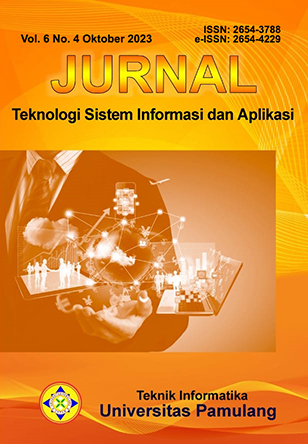Pemilihan Student of the month dengan Metode Simple Additive Weighting (SAW) dan Metode Weighted Product (WP) berbasis web
Kata Kunci:
Sistem Pendukung Keputusan, SPK, student of the month, Simple Additive Weighting, SAW, Weighted Product, WP.Abstrak
Setiap 1 (satu) bulan sekali SMK Nusantara 1 Kota Tangerang memberikan penghargaan untuk siswanya. Penghargaan yang diberikan dalam bentuk student of the month dalam rangka meningkatkan semangat belajar siswa di SMK Nusantara 1 Kota Tangerang. Proses pemilihan student of the month diinisiasi oleh kepala sekolah dengan pertimbangan dari wakil kepala sekolah dan juga para kepala program keahlian. Namun sampai saat ini proses pemilihan student of the month masih ada proses manual yang tidak memperhitungkan karakteristik kriteria penilaian. Oleh karena itu, penelitian ini bertujuan untuk mengevaluasi penggunaan metode Simple Additive Weighting (SAW) dan metode Weighted Product (WP) dalam sistem pendukung keputusan untuk pemilihan student of the month. Penelitian ini dapat membantu kepala sekolah dalam pemilihan student of the month dengan lebih objektif. Dari penelitian ini mendapatkan hasil akhir 0,994 untuk metode SAW dan 0,050 untuk metode WP dan menyatakan bahwa siswa dengan total nilai terbesar adalah Arminanda Khansa Sadiya.
Referensi
Aldisa, R. T., Nugroho, F., Mesran, Sinaga, S. A., & Sussolaikah, K. (2022). Sistem Pendukung Keputusan Menentukan Siswa Terbaik Menggunakan Metode Simple Additive Weighting (SAW). Jurnal ELTIKOM, 2(1), 26–33. https://doi.org/10.31961/eltikom.v2i1.39
Anisa, D., Ningrum, W. S., Kusumo, R., & Putri, W. (2022). Sistem Pendukung Keputusan Penerimaan Beasiswa Menggunakan Metode Weighted Product. TIN: Terapan Informatika Nusantara, 2(8), 483–491. https://doi.org/10.47065/tin.v2i8.1064
Ginting, G., Mesran, & Manalu, Y. F. (2021). Penerapan Metode Simple Additive Weighting (SAW) dalam Pemberian Reward Bagi Pegawai Honorer Menggunakan Pembobotan Rank Order Centroid. Jurnal Media Informatika Budidarma, 5(4), 1667. https://doi.org/10.30865/mib.v5i4.3146
Handika, W., & Sholihin, M. . (2021). SISTEM PENDUKUNG KEPUTUSAN PENILAIAN KINERJA KARYAWAN MENGGUNAKAN METODE SIMPLE ADDITIVE WEIGHTING (SAW) (Studi Kasus : PT. Herman Brothers). 27, 1–10.
Harmayani, & Harahap, R. A. (2022). Perbandingan Metode WP dan SAW dalam Sistem Pendukung Keputusan untuk Menentukan Tingkat Keberhasilan Guru Mengajar di Tingkat SMK. Media Informatika Budidarma, 6(April), 923–932. https://doi.org/10.30865/mib.v6i2.3571
Kamdani, R., & Agustian, B. (2022). Perancangan Sitem Pendukung Keputusan Menggunakan Metode Saw ( Simple Additive Weighting ) Menentukan. Journal of Artificial Intelligence and Innovative Applications,
Lorenzia, B. A., & Zailani, A. U. (2022). Sistem Pendukung Keputusan Karyawan Terbaik Metode SAW dan WP Pada PT . Paramount Bed Indonesia. 1(07), 907–915.
Magdalena, M., & S, F. P. (2021). Implementasi Metode Weighted Product (WP) pada Sistem Pendukung Keputusan Pemberian Bonus Karyawan. JATISI (Jurnal Teknik Informatika Dan Sistem Informasi), 8(4), 2158–2170. https://doi.org/10.35957/jatisi.v8i4.1179
Mulyani, T. (2021). KOMPARASI METODE SAW (SIMPLE ADDITIVE WEIGHTING) DAN WP (WEIGHTED PRODUCT) DALAM SISTEM PENILIAN KINERJA KARYAWAN PADA PT BEONE OPTIMA SOLUSI (Vol. 7).
Pasaribu, S. A., & Darussalam, U. (2022). Komparasi Metode Simple Additive Weighting Dan Metode Weighted Product Web Based Untuk Menentukan Siswa Berprestasi. JIPI (Jurnal Ilmiah Penelitian Dan Pembelajaran Informatika), 7(1), 196–208. https://doi.org/10.29100/jipi.v7i1.2624
Rahayu, S., & Sindar, A. (2022). Sistem Pendukung Keputusan Penilaian Kinerja Guru Menggunakan Metode Simple Additive Weighting. Jurnal Ilmu Komputer Dan Informatika, 2(2), 103–112. https://doi.org/10.54082/jiki.28
Widyakunthaningrum, T., Yudhana, A., & Fadlil, A. (2022). SISTEM PENDUKUNG KEPUTUSAN UNTUK PENENTUAN KELAS UNGGULAN MENGGUNAKAN METODE WEIGHTED PRODUCT. 9(2), 200–206. https://doi.org/10.30656/jsii.v9i2.4224
Wijaya, I. K. A., Dantes, G. R., & Candiasa, I. M. (2021). Implementasi Sistem Pendukung Keputusan Pemilihan Guru dan Siswa Berprestasi dengan Kombinasi Metode Analytical Hierarchy Process dan Technique for Order Preference by Similarity to Ideal Solution. Jurnal Nasional Pendidikan Teknik Informatika (JANAPATI), 10(2), 77. https://doi.org/10.23887/janapati.v10i2.29386
Sahadi, S., Ardhiansyah, M., & Husain, T. (2020). Sistem Pendukung Keputusan Pemilihan Siswa/i Kelas Unggulan Menggunakan Metode AHP dan TOPSIS. Jurnal Teknologi Sistem Informasi, 1(2), 153–167. https://doi.org/10.35957/jtsi.v1i2.513
Unduhan
Diterbitkan
Cara Mengutip
Terbitan
Bagian
Lisensi
Hak Cipta (c) 2023 Muhammad Indra Rizaldi, Makhsun Makhsun, Achmad Hindasyah

Artikel ini berlisensi Creative Commons Attribution-NonCommercial 4.0 International License.
Authors who publish with this journal agree to the following terms:
- Authors retain copyright and grant the journal right of first publication with the work simultaneously licensed under a Creative Commons Attribution License that allows others to share the work with an acknowledgement of the work's authorship and initial publication in this journal.
- Authors are able to enter into separate, additional contractual arrangements for the non-exclusive distribution of the journal's published version of the work (e.g., post it to an institutional repository or publish it in a book), with an acknowledgement of its initial publication in this journal.
- Authors are permitted and encouraged to post their work online (e.g., in institutional repositories or on their website) prior to and during the submission process, as it can lead to productive exchanges, as well as earlier and greater citation of published work (See The Effect of Open Access).
Jurnal Teknologi Sistem Informasi dan Aplikasi have CC BY-NC or an equivalent license as the optimal license for the publication, distribution, use, and reuse of scholarly work.
In developing strategy and setting priorities, Jurnal Teknologi Sistem Informasi dan Aplikasi recognize that free access is better than priced access, libre access is better than free access, and libre under CC BY-NC or the equivalent is better than libre under more restrictive open licenses. We should achieve what we can when we can. We should not delay achieving free in order to achieve libre, and we should not stop with free when we can achieve libre.
This work is licensed under a Creative Commons Attribution-NonCommercial 4.0 International (CC BY-NC 4.0) License
YOU ARE FREE TO:
- Share - copy and redistribute the material in any medium or format
- Adapt - remix, transform, and build upon the material for any purpose, even commercially.
- The licensor cannot revoke these freedoms as long as you follow the license terms



_2020_-_7(2)_2024_-_Thumbnail.png)












